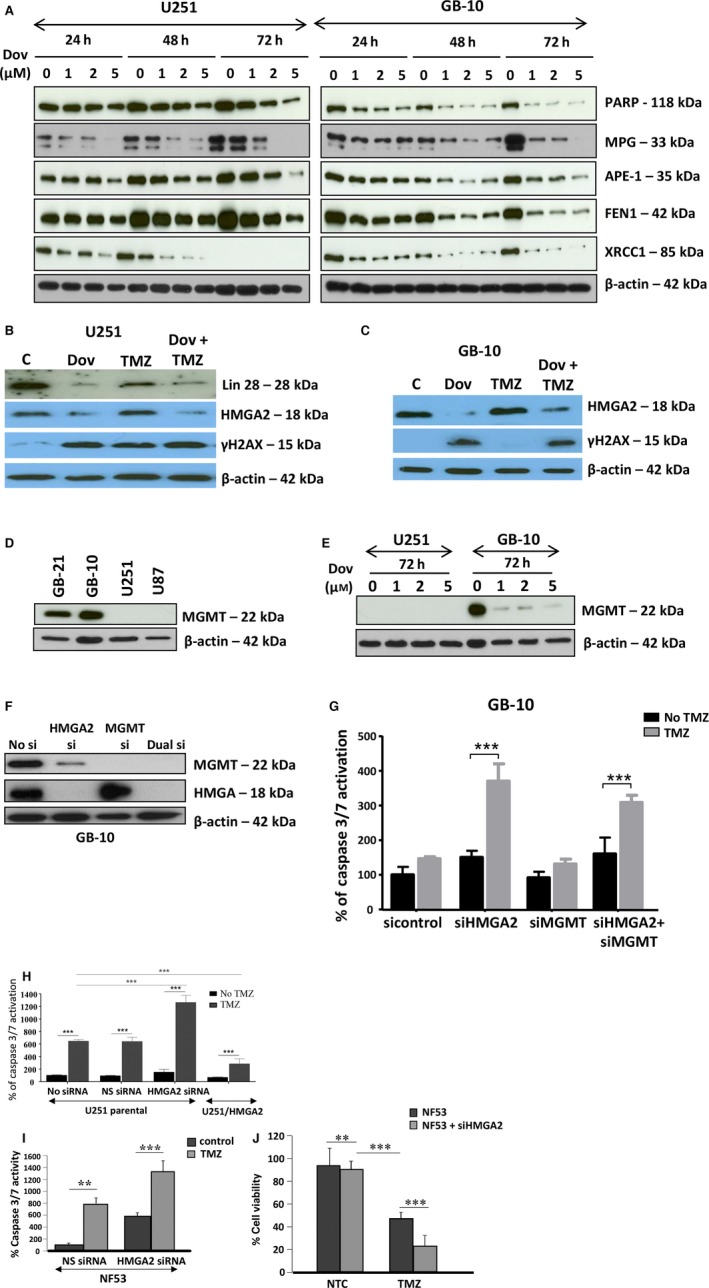Figure 2.

Dovitinib downregulates proteins involved in TMZ‐induced DNA damage repair. (A) Low Dov concentrations at 1, 2, and 5 μm for 24 h, 48 h, and 72 h reduced the BER proteins APE1, MPG, FEN1, PARP1, and XRCC1 with most pronounced effects seen at 72 h as shown here for U251 and GB‐10. (B) In U251, Dov at 5 μm downregulated LIN28 and HMGA2 and increased γH2AX levels at 72 h. TMZ (100 μm) alone did not downregulate Lin28 and HMGA2, but did not prevent Dov (5 μm)‐induced reduction in these proteins in U251 cells. (C) Like with U251 cells, Dov at 5 μm downregulated HMGA2 and increased γH2AX levels at 72 h. TMZ (100 μm) at 72‐h exposure did not decrease HMGA2 protein levels in GB‐10 cells and did not prevent DOV (5 μm)‐induced HMGA2 downregulation. (D) In contrast to the GB cell lines U87 and U251 which were negative for MGMT expression, patient GB cells expressed MGMT protein. (E) Dov consistently downregulated MGMT, shown here for GB‐10. (F) Western blot showing specific KD of HMGA2 or MGMT and dual silencing in GB‐10 cells. (G) Caspase 3/7 assays were performed. Individual silencing of HMGA2 and MGMT and dual HMGA2/MGMT KD showed that apoptosis was strongly induced at 24 h by TMZ (1.5 mm) in patient GB cells with silenced HMGA2, but not upon MGMT silencing or TMZ alone. (H) Compared to U251 cells with endogenous HMGA2, siHMGA2 KD significantly increased caspase 3/7 activity following treatment with TMZ. In contrast, high exogenous cellular HMGA2 levels reduced this caspase 3/7 activity upon TMZ. Similar to human GB cells, HMGA2 KD in mouse NF53 GB cells caused (I) an increase in caspase 3/7 activation, which was dramatically upregulated with TMZ, and (J) a reduction in cell viability over 24h, which was aggravated by TMZ at EC 50 (2 mm) for 24h. Graphs show SEM from three independent experiments; ***P < 0.001; **P < 0.01.
